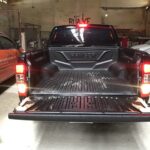Driving a pickup truck can be challenging for beginners. This article provides a detailed guide on how to drive a pickup truck, from basic to advanced techniques, helping you confidently master your vehicle. We will explore the function of each component, how to shift gears, start, move, and stop a pickup truck safely and efficiently.
Functions of Clutch, Brake, and Accelerator Pedals in a Pickup Truck
The three basic pedals in a pickup truck, from left to right, are the clutch, brake, and accelerator. Each pedal has a distinct function:
- Clutch: Controls the connection between the engine and the transmission. Depressing the clutch disengages this connection, allowing you to shift gears or stop the vehicle without stalling the engine.
- Brake: Controls the braking system, helping to reduce speed or stop the vehicle.
- Accelerator (Gas Pedal): Controls the vehicle’s speed. Pressing the accelerator deeper makes the vehicle go faster.
Understanding Gear Shift Symbols in a Pickup Truck
The gear shift lever in a pickup truck typically has the following symbols:
- 1, 2, 3, 4, 5, 6 (or more): Forward gears, used to move the vehicle forward. Higher numbers indicate higher speeds.
- R (Reverse): Reverse gear, used to move the vehicle backward.
- N (Neutral) or 0: Neutral gear, disengages the connection between the engine and the transmission. Used when stopping or starting the engine.
How to Shift Gears in a Pickup Truck Correctly
Shifting gears correctly in a pickup truck is crucial to avoid damage to the transmission and ensure smooth operation.
Steps to Shift Gears:
- Depress the Clutch: Fully depress the clutch pedal.
- Engage Gear: Move the gear lever to the desired gear position according to the gear shift pattern. Each vehicle model may have a different gear pattern.
- Release the Clutch: Gradually release the clutch while gently pressing the accelerator to move the vehicle.
Gear Shift Patterns for Some Vehicle Models:
| Vehicle Model | 1st Gear | 2nd Gear | 3rd Gear | 4th Gear | 5th Gear | Reverse (R) | Neutral (N) |
|---|---|---|---|---|---|---|---|
| Basic | Top Left | Bottom Left | Top Center | Bottom Center | Top Right | Bottom Right | Center |
| Modern | Top Outer Left | Bottom Outer Left | Top Inner Left | Bottom Inner Left | Top Right | Bottom Outer Right | Center |
| Premium | Top Near End Left | Bottom Near End Left | Top Near End Right | Bottom Near End Right | Top End Right | Top Outer Left | Center |
15 Basic Steps on How to Drive a Pickup Truck
- Sit Properly and Fasten Your Seatbelt.
- Understand the Function of the Clutch.
- Adjust the Driver’s Seat for Comfort.
- Depress the Clutch.
- Shift to Neutral (N).
- Start the Engine.
- Gradually Release the Clutch After the Engine Has Started.
- Depress the Clutch and Shift to 1st Gear.
- Release the Handbrake.
- Gradually Release the Clutch and Gently Press the Accelerator.
- Shift to 2nd Gear When the Engine RPM Reaches 2,500 – 3,000 RPM.
- Release the Clutch and Press the Accelerator.
- Repeat Gear Shifting and Accelerating for Subsequent Gears.
- Release the Accelerator, Depress the Brake, and Depress the Clutch When You Want to Stop.
- Practice Regularly.
Conclusion
Driving a pickup truck requires smooth coordination between the clutch, accelerator, and gear shift. Hopefully, this article has provided you with the basic knowledge of how to drive a pickup truck. Practice regularly to improve your skills and drive safely.
